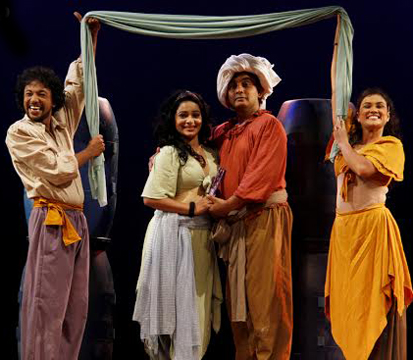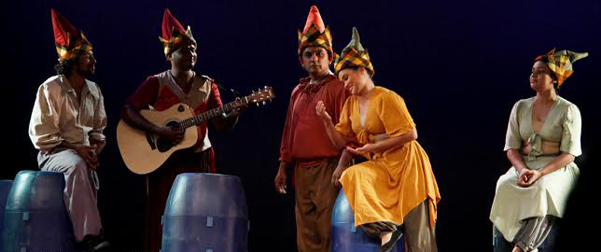|
DRAMA Review
Raja Mang Vahala:
A theatrical critique gone awry
by
Dilshan Boange
 A five-actor ensemble garbed in a somewhat gypsy costume motif
mounted the boards of the Tower Hall theatre on March 21 to unfold
Chamika Hathlahawatte's theatrical creation Raja Mang Vahala. As a play
performed in the proscenium it was akin to a street drama, with the
narrators/players themselves playing a band of roaming performers
reminiscent of times when bards roamed the countryside singing epic
tales of legendary heroes. I couldn't help but feel there was somewhat
patronising tone in the opening of the play, where the troupe tell the
audience the traditions of bards who composed and narrated great epics
like the Iliad and Odyssey. It seems the playwright/director believes he
has to historically validate to his audience the basis on which his work
seeks to derive justification for purported 'theatre craft' and 'form'. A five-actor ensemble garbed in a somewhat gypsy costume motif
mounted the boards of the Tower Hall theatre on March 21 to unfold
Chamika Hathlahawatte's theatrical creation Raja Mang Vahala. As a play
performed in the proscenium it was akin to a street drama, with the
narrators/players themselves playing a band of roaming performers
reminiscent of times when bards roamed the countryside singing epic
tales of legendary heroes. I couldn't help but feel there was somewhat
patronising tone in the opening of the play, where the troupe tell the
audience the traditions of bards who composed and narrated great epics
like the Iliad and Odyssey. It seems the playwright/director believes he
has to historically validate to his audience the basis on which his work
seeks to derive justification for purported 'theatre craft' and 'form'.
Rhythmic movements
The stagecraft for this play was based on improvising and devising
stage props out of several blue plastic barrels and numerous lengths of
fabric, while a guitar was used as part of the music generation.
Drumming the barrels was very significant to the musicality woven into
the performance and to this effect I couldn't help but notice how actor
Sarath Karunaratne (aka 'Sara') who is superlatively skilled in
generating percussion music seemed essential to his production.
The principal 'theatricality' of the work comes from the movement of
players as they transform themselves into dancers and amateur acrobats.
Their rhythmic movements, the musicality generated through both
percussion and guitar strumming by Thilanka Gamage, and vocals added
elements of showmanship. The performance's core is by and large a
structure of oral narratives of three stories where the actors ask the
audience to adjudge which of the protagonists comes out as the 'hero'.
The narrative craft of the script rests on several players switching
between them the lines of a common narrative, personifying what is
somewhat like (the function of) the prose description in a novel, but
played out by several live players.
The first of the three narrative tales is of an ugly slave destined
to marry a princess, the second tells the story of young prince Gemunu
who grows up to be Dutugemunu and the third of a schoolboy named
Premathilaka, who on being spurned by his love interest murders her. The
third story relates to a true incident that was reported in the press
some time back.
 Raja
Mang Vahala makes a laborious attempt to create a critique for
cotemporary Sri Lanka through drama, but delivers little in the fold of
theatre craft. As a work for the proscenium, it demands far too much as
a performance that runs for two hours resting on a modus operandi
lacking creative investment, banking on oral storytelling creating the
fundamental premise of a verbal discourse divided as dialogue between
players who switch between the characters they describe, and also
monologues addressing the audience directly. But of course the players
did perform as actors who interspersed theatrical actions to complement
the oral output. What was thus shown goes back to the primitivism of
what theatre began for rustic masses of ages past. Raja
Mang Vahala makes a laborious attempt to create a critique for
cotemporary Sri Lanka through drama, but delivers little in the fold of
theatre craft. As a work for the proscenium, it demands far too much as
a performance that runs for two hours resting on a modus operandi
lacking creative investment, banking on oral storytelling creating the
fundamental premise of a verbal discourse divided as dialogue between
players who switch between the characters they describe, and also
monologues addressing the audience directly. But of course the players
did perform as actors who interspersed theatrical actions to complement
the oral output. What was thus shown goes back to the primitivism of
what theatre began for rustic masses of ages past.
Vilified and demonised
Raja Mang Vahala had clownish antics that at time made the basis for
comedic theatrics, but seemed utterly juvenile in certain instances, as
for example in the first of the trio of stories. However, if one wants
to look at what comedy can do to challenge established beliefs, a facet
of it came out through the second 'story'. It was the story of King
Dutugemunu from a prince to a king and what this historical figure
signifies in relation to the Sinhala Buddhist ethos. Through their
schema of theatrics, both oral and physical, the players vilified and
demonised the legend of Prince Gemunu (who grows up to become King
Dutugemunu). That I believe would be the meat of this work to offer some
semblance of critique theatre.
The nonstop verbosity of the narrative method was times monotonous
and an aural tedium. The chorus of song at the outset and towards the
end showcase the players' commitment to 'entertain' and willingness to
even 'dance till they bust their ribs'. One can't help wondering why the
playwright felt the need to insert such 'expressions' to deliver the
'promise of entertainment'. One can't also help comparing Pujitha de
Mel's Asinamaali with Raja Mang Vahala as a play that rests principally
on its players' prowess to physically and orally deliver a script to
captivate an audience. There is much to be learned from the former.
While Raja Mang Vahala shows it is assembled of varying elements from
song to dance, musicality and theatrics of players that offer some
'threads' of entertainment and socio-political-cultural critique, the
work is largely impoverished in its 'fabrication' to offer appreciable
theatre.
|

